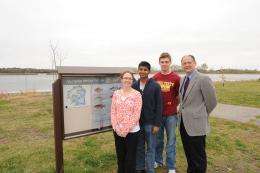Study finds Vision Iowa provided healthy return on investment

A new report by Iowa State University economics faculty and students found that the state's Vision Iowa program -- which was instituted in 2001 to enhance recreational, cultural, educational or entertainment attractions available across the state -- made the state an annual 9.2 percent return on investment in terms of increased sales tax revenue through 2008. Local communities also saw nearly a 1 percent annual return on their investment in the resulting amenities.
The Vision Iowa program spurred almost $2 billion in new public facilities and improvements through 393 projects in 94 of Iowa's 99 counties from 2001-08.
Austin Quackenbush and Deepak Premkumar, now ISU sophomores, conducted the analysis under the guidance of Peter Orazem, University Professor of economics; and Georgeanne Artz, a visiting assistant professor of economics in the College of Agriculture and Life Sciences.
"If there's one thing that people complain about in Iowa other than the weather, it's that there aren't enough of these cultural amenities," Orazem said. "And so Vision Iowa was a way to enhance that, and the state paid about 20 percent and the local communities had to come up with 80 percent [of the cost of the amenities].
"We found that we get this significant bump up in retail sales from these amenities," he continued. "And oddly enough, because the state gets five out of every seven cents in sales tax, the state atypically benefitted from these programs because they only paid a fifth of the cost. The state's return in constant dollars -- these are inflation-adjusted dollars -- was 9.2 percent a year. You can't do better than that. Over this period of time, that's one of the better investments one could have ever seen."
The ISU researchers used data from the Iowa Retail Sales and Use Tax Reports, published annually by the Iowa Department of Revenue and Finance; the Bureau of Labor Statistics; and specific Vision Iowa projects from the Iowa Department of Economic Development in their analysis. Orazem says the analysis only reflects data through 2008 because the state changed how it reported sales tax data in 2009.
Quackenbush was a freshman in Iowa State's Entrepreneurship and Innovation Learning Community -- supported by ISU's Pappajohn Center for Entrepreneurship -- when he approached Orazem about working on a project related to Iowa business and entrepreneurship. Premkumar was also a freshman in ISU Honors Program when he too came to Orazem looking for a project.
Quackenbush wound up compiling the data on all the Vision Iowa projects. With assistance from Artz, Premkumar analyzed the retail data related to those projects, working into the summer to complete his analysis.
"I was really interested in the research and so I just wanted to follow up from the spring semester this summer," said Premkumar, who is from Ames and planning to become an economics major, in part because of the project. "What we first expected was to complete the research in the summer pretty quickly and then I was going to move onto a different project. But we just kept on working from a really good data set and adding different aspects to the paper, which we hope will be a nice journal article."
"A lot of these projects bring revenue and visitors into Iowa, which is not known as a tourist attraction per se," said Quackenbush, a business economics major from Minnetonka, Minn. "It would help Iowa to encourage [localities to build more public attractions]."
Their report found that even the counties around the new Vision Iowa projects also saw a small increase in their sales revenue after the new amenities were built. Orazem says that's even further evidence that Vision Iowa was a "win-win" for both the state and local communities that benefited from the projects that were funded.
"What's interesting is here's a public policy where people are building amenities, and because the communities had to put up the bulk of the money, they ended up being good projects," Orazem said. "And there are reasons why Iowa ought to have programs like this to help local areas develop entertainment, recreational and cultural attractions; spaces that help benefit the public as a whole, but also make the area more attractive -- both to visitors, or to new residents."
The authors have submitted the paper for publication in a professional journal.
More information: www.econ.iastate.edu/sites/def … 14375-2011-10-09.pdf
Provided by Iowa State University


















